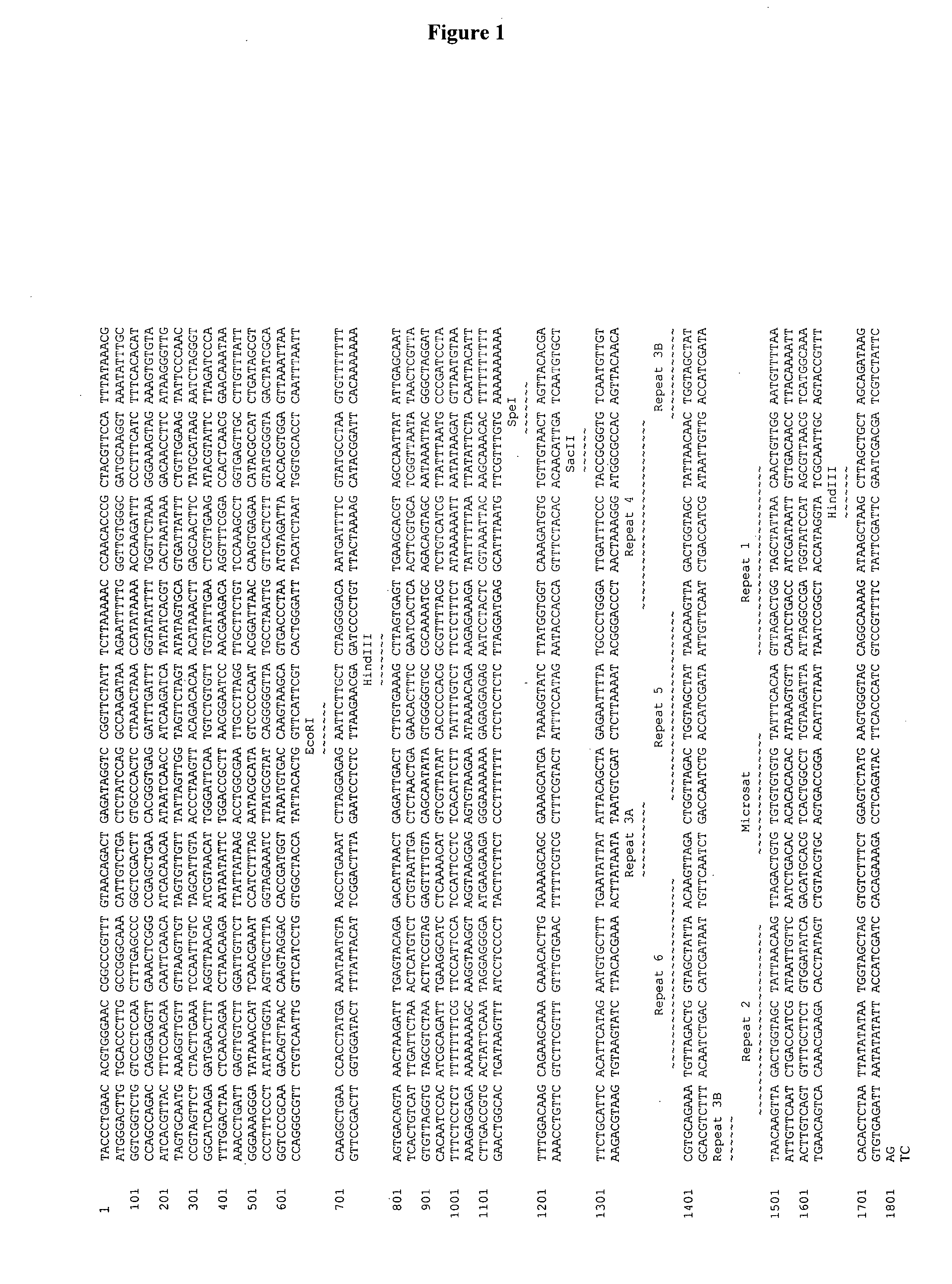Chimeric Compositions and Methods for Regulating Plant Gene Expresssion
a technology of chimeric compositions and compositions, applied in the field of polynucleotides for regulating gene expression in plants, can solve the problems of limited gene manipulation of such traits in apples, and these and other traits in other species, and achieve the effect of reducing the number of chimeric compositions
- Summary
- Abstract
- Description
- Claims
- Application Information
AI Technical Summary
Benefits of technology
Problems solved by technology
Method used
Image
Examples
example 1
Isolation of the Full Length MdMYB10 Promoter Polynucleotides from White-Fleshed and Red-Fleshed Apple Cultivars, and Identification of Additional Elements within the Promoter from the Red-Fleshed Cultivar
Isolation of Genomic DNA
[0328]Genomic DNA was isolated from the leaves of a white-fleshed apple cultivar (Malus domestica Royal Gala) and from the leaves of a red-fleshed apple cultivar (Malus×pumila niedwetzkyana) using a Qiagen DNeasy Plant Mini Kit, according to the manufacturers instructions (Qiagen, Valencia, Calif.).
Promoter Isolation
[0329]A 1.7-1.8 Kb region of the upstream regulatory region of the MdMYB10 gene was isolated from the DNA of both the white-fleshed and the red-fleshed cultivar by PCR genome walking using a GenomeWalker™ kit (Clontech, Mountain View, Calif.), following the manufacturers instructions.
[0330]The isolated promoters were sequenced by standard techniques. The sequence of the promoter from the red-fleshed cultivar is shown in SEQ ID NO: 5. The sequence...
example 2
Demonstration of Regulation of Expression of Operably Linked Polynucleotide Sequences by the Promoter Polynucleotides of the Invention
Dual Luciferase Assay of Transiently Transformed Tobacco Leaves
[0338]The promoter sequences for MdMYB10 from the red-fleshed and white-fleshed cultivars (SEQ ID NOs: 4 and 5 respectively) were separately inserted into the cloning site of pGreen 0800-LUC (Hellens et al., 2005, R. P. Hellens, A. C. Allan, E. N. Friel E N, K. Bolitho, K. Grafton, M. D. Templeton, S. Karunairetnam, W. A. Laing, Plant Methods 1:13). In the same construct, a luciferase gene from Renilla (REN), under the control of a 35S promoter, provided an estimate of the extent of transient expression. Activity is expressed as a ratio of LUC to REN activity. The promoter-LUC fusion was used in transient transformation by mixing 100 μl of Agrobacterium strain GV3101 (MP90) transformed with the reporter cassette with or without another Agrobacterium culture (900 μl) transformed with a cass...
example 3
The Presence of the Minisatellite Unit in the Promoter of the Invention is Consistently Associated with Red-Flesh in Naturally Occurring Red-Fleshed Apple Varieties
Minisatellite Region PCR Amplification and Sequencing
[0341]The fruit flesh (cortex) of most apple cultivars is white or off-white in colour. The skin is usually green or red, the skin reddening in response to developmental, hormonal and light signals (Ubi et al., 2006, Plant Sci. 170, 571). There are, however, a number of high anthocyanin, red-fleshed apples, including Malus×pumila niedzwetzkyana, originating from the wild-apple forests of Khazakhstan.
[0342]In apple, anthocyanin accumulation is specifically regulated by MdMYB10, with MdMYB10 transcript levels greatly elevated in red-fleshed varieties (Espley et al., 2007, Plant J. 49, 414).
[0343]Genomic DNA samples from several red-fleshed and white-fleshed apple cultivars listed in the Table 1 below were supplied by Charles J Simon and Philip Forsline, Agricultural Resea...
PUM
| Property | Measurement | Unit |
|---|---|---|
| Tm | aaaaa | aaaaa |
| volume | aaaaa | aaaaa |
| pest resistance | aaaaa | aaaaa |
Abstract
Description
Claims
Application Information
 Login to View More
Login to View More - R&D
- Intellectual Property
- Life Sciences
- Materials
- Tech Scout
- Unparalleled Data Quality
- Higher Quality Content
- 60% Fewer Hallucinations
Browse by: Latest US Patents, China's latest patents, Technical Efficacy Thesaurus, Application Domain, Technology Topic, Popular Technical Reports.
© 2025 PatSnap. All rights reserved.Legal|Privacy policy|Modern Slavery Act Transparency Statement|Sitemap|About US| Contact US: help@patsnap.com



